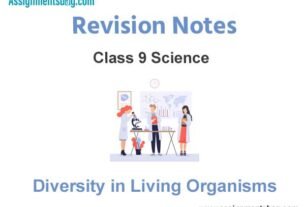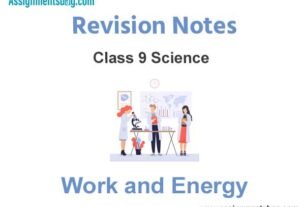Please refer to the Tissues Revision Notes given below. These revision notes have been designed as per the latest NCERT, CBSE and KVS books issued for the current academic year. Students will be able to understand the entire chapter in your class 9th Science book. We have provided chapter wise Notes for Class 9 Science as per the latest examination pattern.
Revision Notes Chapter 6 Tissues
Students of Class 9 Science will be able to revise the entire chapter and also learn all important concepts based on the topic wise notes given below. Our best teachers for Grade 9 have prepared these to help you get better marks in upcoming examinations. These revision notes cover all important topics given in this chapter.
Tissue is a group of cells having similar origin, structure& function. Study of tissues is called Histology.
In unicellular organism (Amoeba) single cell performs all basic functions, whereas in multi-cellular organisms (Plants and Animals) shows division of labor as Plant tissue & Animaltissues.
Plant tissues are two types: Meristems & Permanent tissues.
Meristems: The Meristems are the tissues having the power of cell division. It is found on those region of the plant which grows.
Types of Meristems;
1. The Apical meristems – It is present at the growing tip of the stem and roots and increases the length.
2. The lateral meristems – present at the lateral side of stem anf root (cambium) and increases the girth.
3. The intercalary meristems -present at internodes or base of the leaves and increases the length between the nodes.
Permanent tissues: Two types such as Simple permanent tissues & Complex permanent tissues.
a) Simple permanent tissues: subdivided as
(i) Parenchyma: Tissues provide the support to plants.They are loosly packed and has large intracellular space.
• Parenchyma with chlorophyll which performs photosynthesis is called as chlorenchyma.
• The parenchyma with large air spaces to give buoyancy is called as aerenchyma .Parenchyma also stores food and water.
(ii) Collenchyma: Tissue provides mechanical support, thickened at the corners, have very little intercellular space. It allows easy bending of various parts of a plants without breaking
(iii) Sclerenchyma: Tissue makes the plant hard and stiff, thickened due to lignin and no intercellular space. Cells of this tissue are dead and commonly seen in the husk of coconut.
(iv) Guard cells& Epidermal tissue: the tissue aids in protection and exchange of gases. Guard cells kidney shaped in dicots, dumb bell shaped in monocots to guard the stomata. The epidermal tissues of roots aid in absorption of water and minerals. The epidermal tissues in desert plants have a thick waxy coating of Cutin with waterproof quality. The epidermal tissues form the several layer thick Cork or the Bark of the tree.
b) Complex permanent tissues: The complex tissues are made of more than one type of cells. All these cells coordinate to perform a common function.
They are subdivided as;
Xylem: It consists of tracheids, vessels, xylem parenchyma and xylem fibers. The cells have thick walls,
Function: aids in conduction of water and minerals.
Phloem: It consists of sieve tubes, companion cells, phloem parenchyma, and phloem fibers.
Function: Phloem transports food material to other parts of the plants.
Animal tissues: Sub divided as epithelial tissue, connective tissue, muscular tissue and nervous tissue.
Epithelial tissue: It is a protective covering forming a continuous sheet. Simple epithelium is the one which is extremely thin in one layer, whereas stratified epithelium are arranged in pattern of layers.
Depending on shape and function they are classified as:
a) Squamous epithelium in the lining of mouth and esophagus.
b) Cuboidal epithelium in the lining of kidney tubules and salivary glands.
c) Columnar epithelium in the intestine &Columnar epithelium with cilia in the lining of respiratory tract.
d) Glandular epithelium in the Glands aids in a special function as gland cells, which can secrete at the epithelial surface.
ii) Connective Tissue: Five Types, such as;
a) Blood: The Blood is a fluid connective tissue. Blood plasma has RBCs (Red Blood Cells) WBCs (White Blood Cells) and platelets. Blood plasma contains proteins, salts and hormones. Blood flows and transports gases, digested food, hormones and waste materials.
b) Bone: The bone is a connective tissue with hard matrix, composed of calcium and phosphorus. A bone is connected by another bone with another connective tissue called ligaments. A bone is connected by muscle with another connective tissue called tendon.
c) Cartilage: The cartilage is a connective tissue with solid matrix composed of proteins and sugars. It is commonly seen in nose, ear, trachea, and larynx.
d) Areolar Connective Tissue: It is found between the skin and muscles, around the blood vessels. It supports internal organs and aids in repair of tissues.
e) Adipose Connective Tissue: It is filled with fat globules for the storage of fat. It acts as insulator.
Muscular tissues: They have special contractile proteins responsible for movements. Three types, such as;
Striated muscles/skeletal muscles/voluntary muscles : They are cylindrical, un-branched and multinucleated.They have dark bands and light bands.
Unstriated muscles/smooth muscles/involuntary muscles: They are commonly called as Smooth muscles, having no striations (dark bands/ light bands are absent). Commonly found alimentary canal, uterus, Iris of an Eye. They are spindle shaped. Involuntary in nature
Cardiac Muscles: They are commonly called as Heart muscles, cylindrical, branched and uni-nucleate. Involuntary in nature.
Nervous Tissue: The tissue responds to stimuli. The brain, spinal cord and nerves are composed of nervous tissue or neurons. A neuron consists of Cell Body, cytoplasm, Nucleus, Dendrite, Axon, nerve ending. The neuron impulse allow us to move our muscles when we want to respond to stimuli.
Important Question and Answer
Question. Name the three muscular tissues in the animals……..
Answer
Striated muscles ,Un- Striated muscles, Cardiac Muscles
Question. Define the term tissue…………….
Answer
A group of cells forms tissue
Question. How many types of meristems are present in plants?
Answer
3 : Apical meristems, Lateral meristem, Intercalary meristem
Question. Distinguish between ligament and tendon.
Answer
A bone to bone connective tissue called ligament. A bone to muscle connective tissue called tendon
Question. Give the details of epidermal tissue in Plants.
Answer
For protection and exchange of gases. Guard cells kidney shaped in dicots, dumb bell shaped in monocots to guard the stomata. The epidermal tissues of roots aid in absorption of water and minerals
Question. Which elements constitute the Phloem?
Answer
Sieve tubes, companion cells, phloem parenchyma, and phloem fibers
Question. What is Histology?
Answer
Study of different tissues
Question. Which plant tissue makes the plant hard and stiff and thickened due to lignin with no intercellular spaces …………………….
Answer
Sclerenchyma
Question. Name the Parenchyma with chlorophyll which performs photosynthesis…………………
Answer
chlorenchym



